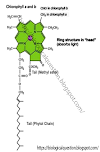Opening and Closing of Stomata
You have already studied the structure and distribution of stomata in section 10.2.2. Stomata are generally open in day and close at night. The opening and closing of stomata depends upon the changes in the turgidity of guard cells. When guard cells are turgid, the stomata are fully opened but when they become flaccid, the stomata are closed. There are two theories, which may explain the opening and closing of stomata: (a) Starch sugar interconversion theory, (b) K* ions Influx/efflux theory.
Starch sugar interconversion theory :
According to this theory, the guard cells are the only photosynthesizing cells of leaf epidermis because they have high chlorophyll content than the surrounding epidermal cells. In the morning when plant is exposed to light, the process of photosynthesis is started. As the concentration of glucose (sugar) is increased, the solute potential and water potential of guard cells become low (more negative). Since, the surrounding epidermal cells have high water content at that time so water begins to move from surrounding epidermal cells to the guard cells. The entry of water into the guard cells makes them tugid and thus, stromata are opened.
In the evening when the process of photosynthesis is stopped, the concentration of glucose is decreased because some glucose has been consumed in respiratory activities of guard cells, some of it is transformed into sucrose so that it can be transported to other parts, and the remaining glucose is converted into insoluble starch and is stored for later use. The decrease in glucose concentration causes an increase in water potential of the guard cells. In this way, water begins to move from guard cells to surrounding epidermal cells. Due to loss of water water guard cells become flaccid, thus stomata are closed.
K+ ions Influx/efflux theory
According to this theory, the start of photosynthetic activity in the morning when plant is exposed to light, causes a decrease in level of CO2 in the guard cells. Low level of CO2 favours or stimulates the influx (inward movement) of K ions (shown in red dots in the fig. 10.8) into the guard cells from the surrounding epidermal cells by active transport. At the same time, malic acid is ionized into malate ions and H ions due to the exposure of blue light (a part of visible light). The accumulation of H+ ions causes decrease in pH of guard cells, which are then pumped to surrounding epidermal cells in order to maintain the pH of guard cells. The incoming K+ ions are combined with malate ions to form potassium malate which is highly soluble in water thus decreases the water potential of the guard cells. In this way water begins to move from surrounding epidermal cells to guard cells. The entry of water into the guard cells makes them turgid and thus, stomata are opened.
In the evening, the photosynthetic activity is stopped and level of CO2 rises in guard cells. High level of CO2 favours or stimulates the efflux (outward movement) of K+ ions (shown in red dots in the fig. 10.8) from the guard cells into the surrounding epidermal cells by active transport. At the same time, malic acid is reformed by the combination of malate ions and H ions as there is no exposure of blue light now. Due to the absence of potassium malate, the water potential of the guard cells are increased. In this way, water begins to move to surrounding epidermal cells from guard cells. The loss of water from the guard cells makes them flaccid and thus, stomata are closed.
(i) Stomata Opening (ii) Stomata Closing
Thank you for Reading the Article.


%20Stomata%20Opening%20(ii)%20Stomata%20Closing.png)
.png)

.png)
0 Comments